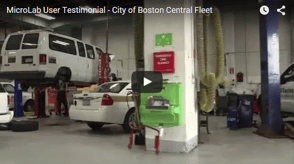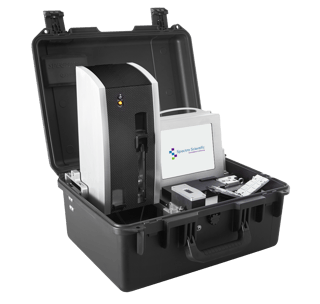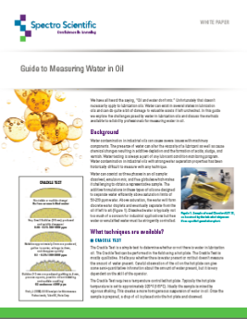City of Boston Central Fleet uses MicroLab
MicroLab optimizes workflow of busy maintenance garage
The City of Boston’s Central Fleet Garage wanted to take a more proactive role in preventative maintenance of the equipment serviced at its facility, so the Garage decided to investigate onsite oil analysis solutions. The Central Fleet Garage reorganized in 2013 and with that reorganization sprung a focus on improving cost effectiveness for the tax payers of Boston. Central Fleet then identified oil analysis as a key enabler for cost and efficiency improvements.

In 2013, Central Fleet implemented an onsite oil analyzer from Onsite Analysis, now Spectro Scientific. According to the Superintendent of the Central Fleet Garage, the analyzer has been beneficial in enabling Central Fleet to extend oil drain intervals. For example, the mechanic samples and tests the oil. In 15 minutes, he can determine whether an oil change is required or if the oil drain can be extended another cycle. It enables the mechanics to work quicker and smarter, which is what Central Fleet was searching for when they discovered the TruckCheck®, now called the MicroLab® analyzer.
Oil drain interval extension saves the cost of oil, filters, disposal and labor in today’s MRO budget. Even greater savings are realized from diagnosing mechanical problems before they lead to catastrophic failure, preventing lost productivity of asset availability and operation.
Preventive Maintenance Workflow at Central Fleet Garage
The Central Fleet mechanics bring in various pieces of equipment (sanitation trucks, snow plows, etc.) as they are scheduled for preventative maintenance. The mechanic will draw oil samples and put them on the machine. The equipment is then placed on the lift, and the mechanic will start the safety portion of that preventative maintenance check.
In the meantime, the MicroLab analyzer has already run the oil analysis and the technician knows whether or not the oil needs to be changed or whether they can extend the oil drain interval. If the analyzer indicates that the oil is within the normal specification range, the mechanic is good to go. He can extend the oil interval and finish the preventative maintenance. The fleet vehicle is ready to go back into the field.
To read the full interview about maintenance operations at City of Boston’s Central Fleet Garage, please click here.
Free eGuide - Measuring Water in Oil
Five Methods to Measure Water Contamination in Oil
We have all heard the saying, “Oil and water don’t mix.” Unfortunately that doesn’t
necessarily apply to lubrication oils. Water can exist in several states in lubrication
oils and can do quite a bit of damage to valuable assets if left unchecked. In this guide we explore the challenges posed by water in lubrication oils and discuss the methods available to reliability professionals for measuring water in oil.
Background
Water contamination in industrial oils can cause severe issues with machinery
components. The presence of water can alter the viscosity of a lubricant as well as cause
chemical changes resulting in additive depletion and the formation of acids, sludge, and varnish. Water testing is always a part of any lubricant condition monitoring program.

Water contamination in industrial oils with strong water separation properties has been
historically difficult to measure with any technique. Water can coexist as three phases in an oil sample: dissolved, emulsion mix, and free globules which makes it challenging to obtain a representative sample. The additive formulations in these types of oils are designed to separate water efficiently above saturation limits of 50-250 ppm water. Above saturation, the water will form discrete water droplets and eventually separate from the oil if left to sit. Dissolved water is typically not too much of a concern for industrial applications but free water or emulsified water must be stringently controlled.
The five methods covered in this guide include:
- The Crackle Test
- Relative Humidity
- Karl Fischer Titration
- Calcium Hydride Test Kits
- IR Spectroscopy
To learn more about these techniques, please download your complimentary guide by clicking on the image below.
Bringing Oil Analysis to Offshore Oil Rigs
Q5800 Field Lab Makes "House Calls" on Offshore Rigs
It is hard to think of another environment where an equipment failure could have a greater negative impact on employee safety and lost production than an offshore oil and gas production platform. Yet offshore platforms are among the world’s most difficult locations to operate and maintain equipment. In most cases, skilled people and supplies can only reach the platform by ship or helicopter so the cost of bringing technical specialists, replacement equipment, spare parts and tools to the platform is high.

On nearly every offshore platform, oil analysis plays a critical role by alerting the maintenance team to problems that may damage a vital system. An effective oil analysis program also helps to efficiently allocate scarce resources by planning maintenance based on equipment condition rather than time intervals. Most offshore platforms take oil samples and ship them by helicopter to onshore labs for analysis. Once the results are available, they are sent back to the platform.
The problem with this approach is it might take a week for the sample to reach the lab, another week for the lab to perform the analysis, another week to process the results and get them back to platform, and perhaps one more week before technicians view the results and take action. By the time the results are acted upon, the equipment may have failed. This could put personnel at risk and cause production outages or require costly shipments of replacement parts.
A new approach involves flying a technician with a portable oil analysis tool to the rig. The technician samples all of the equipment on the rig and provides instantaneous feedback. Immediate maintenance actions can be taken to avoid equipment failure. The operator can also determine the equipment which requires non-urgent maintenance or the assets that do not require any maintenance. This information allows valuable on-platform resources to be used for other duties.
It costs more than $1 billion to operate a typical production platform over its 10 to 20-year life cycle, so operating costs per day can be estimated at $100,000 to $300,000. A typical offshore platform contains millions of dollars of machinery that is critical to the crew’s safety and whose failure can easily put the platform out of operation. Oil analysis has long been the gold standard in the offshore industry for monitoring the condition of critical equipment. Oil analysis determines the amount of various metals in the oil, providing a fast and inexpensive way to gauge the amount of wear in the machinery. Oil analysis also helps determine the condition of the oil by measuring solids formed by oxidation and by measuring the viscosity. Monitoring oil condition reduces the risk of catastrophic failure and can also reduce the high cost of changing and disposing of oil in heavy machinery.
To read the complete case please click here.







